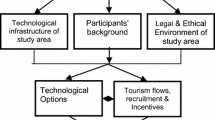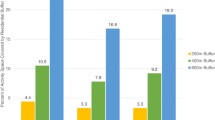Abstract
Tracking the movements of homeless populations presents methodological difficulties, but understanding their movements in space and time is needed to inform optimal placement of services. This pilot study developed, tested, and refined methods to apply global positioning systems (GPS) technology paired with individual narratives to chronicle the movements of homeless populations. Detail of methods development and difficulties encountered and addressed, and geospatial findings are provided. A pilot sample of 29 adults was recruited from a low-demand homeless shelter in the downtown area of Fort Worth, Texas. Pre- and post-deployment interviews provided participant characteristics and planned and retrospectively-reported travels. Only one of the first eight deployments returned with sufficient usable data. Ultimately 19 participants returned the GPS device with >20 h of usable data. Protocol adjustments addressing methodological difficulties achieved 81 % of subsequent participants returning with sufficient usable data. This study established methods and demonstrated feasibility for tracking homeless population travels.


Similar content being viewed by others
References
Bindman, A. B., Grumbach, K., Keane, D., & Lurie, N. (1993). Collecting data to evaluate the effect of health policies on vulnerable populations. Family Medicine, 25, 114–119.
Canavan, R., Barry, M. M., Matanov, A., Barros, H., Gabor, E., Greacen, T., et al. (2012). Service provision and barriers to care for homeless people with mental health problems across 14 European capital cities. BMC Health Services Research, 12, 222.
Conover, S., Berkman, A., Gheith, A., Jahiel, R., Stanley, D., Geller, P. A., et al. (1997). Methods for successful follow-up of elusive urban populations: an ethnographic approach with homeless men. Bulletin of the New York Academy of Medicine, 74, 90–108.
Doherty, S. T., Lemieux, C. J., & Canally, C. (2014). Tracking human activity and well-being in natural environments using wearable sensors and experience sampling. Social Science and Medicine, 106, 83–92.
Duncan, M. J., Mummery, W. K., & Dascombe, B. J. (2007). Utility of global positioning system to measure active transport in urban areas. Medicine & Science in Sports & Exercise, 39, 1851–1857.
Fazel, S., Khosla, V., Doll, H., & Geddes, J. (2008). The prevalence of mental disorders among the homeless in western countries: systematic review and meta-regression analysis. PLoS Medicine, 5, e225.
Folsom, D. P., Hawthorne, W., Lindamer, L., Gilmer, T., Bailey, A., Golshan, S., et al. (2005). Prevalence and risk factors for homelessness and utilization of mental health services among 10,340 patients with serious mental illness in a large public mental health system. American Journal of Psychiatry, 162, 370–376.
Foster, S., LeFauve, C., Kresky-Wolff, M., & Rickards, L. D. (2010). Services and supports for individuals with co-occurring disorders and long-term homelessness. Journal of Behavioral Health Services and Research, 37, 239–251.
Greenberg, G. A., & Rosenheck, R. A. (2010a). Correlates of past homelessness in the National Epidemiological Survey on Alcohol and Related Conditions. Administration and Policy in Mental Health and Mental Health Services Research, 37, 357–366.
Greenberg, G. A., & Rosenheck, R. A. (2010b). Mental health correlates of past homelessness in the National Comorbidity Study Replication. Journal of Health Care for the Poor and Underserved, 21, 1234–1249.
Henry, R., Richardson, J. L., Stoyanoff, S., Garcia, G. P., Dorey, F., Iverson, E., et al. (2008). HIV/AIDS health service utilization by people who have been homeless. AIDS and Behavior, 12, 815–821.
Le Faucheur, A., Abraham, P., Jaquinandi, V., Bouye, P., Saumet, J. L., & Noury-Desvaux, B. (2007). Study of human outdoor walking with a low-cost GPS and simple spreadsheet analysis. Medicine & Science in Sports & Exercise, 39, 1570–1578.
Levitt, A. J., Culhane, D. P., DeGenova, J., O’Quinn, P., & Bainbridge, J. (2009). Health and social characteristics of homeless adults in Manhattan who were chronically or not chronically unsheltered. Psychiatric Services, 60, 978–981.
Liebow, E. (1967). Tally’s corner: A study of Negro streetcorner men. Boston: Little, Brown, & Company.
Martens, W. H. (2001). A review of physical and mental health in homeless persons. Public Health Review, 29, 13–33.
Meijles, E. W., de Bakker, M., Groote, P. D., & Barske, R. (2014). Analysing hiker movement patterns using GPS data: implications for park management. Computers, Environment & Urban Systems, 47, 44–57.
Moore, G., Manias, E., & Gerdtz, M. F. (2011). Complex health service needs for people who are homeless. Australian Health Review, 35, 480–485.
North, C. S., Eyrich, K. M., Pollio, D. E., Foster, D. A., Cottler, L. B., & Spitznagel, E. L. (2004a). The Homeless Supplement to the Diagnostic Interview Schedule: test–retest analyses. International Journal of Methods in Psychiatric Research, 13, 184–191.
North, C. S., Eyrich, K. M., Pollio, D. E., & Spitznagel, E. L. (2004b). Are rates of psychiatric disorders in the homeless population changing? American Journal of Public Health, 94, 103–108.
Oliver, M., Badland, H., Mavoa, S., Duncan, M. J., & Duncan, S. (2010). Combining GPS, GIS, and accelerometry: Methodological issues in the assessment of location and intensity of travel behaviors. Journal of Physical Activity and Health, 7, 102–108.
Orellana, D., & Wachowicz, M. (2011). Exploring patterns of movement suspension in pedestrian mobility. Geographical Analysis, 43, 241–260.
Page, J. (2007). Barriers to transferring care of homeless people with serious mental illnesses to community mental health organizations: perspectives of street-based programs. Best Practices in Mental Health: An International Journal, 3, 16–25.
Pollio, D. E., Eyrich-Garg, K. M., & North, C. S. (2010). The homeless. In B. A. Johnson (Ed.), Addiction medicine: Science and practice (pp. 1487–1504). New York: Springer.
Pollio, D. E., North, C. S., Eyrich, K. M., Foster, D. A., & Spitznagel, E. (2003). Modeling service access in a homeless population. Journal of Psychoactive Drugs, 35, 487–495.
Stergiopoulos, V., Dewa, C., Durbin, J., Chau, N., & Svoboda, T. (2010). Assessing the mental health service needs of the homeless: A level-of-care approach. Journal of Health Care for the Poor and Underserved, 21, 1031–1045.
Taczanowska, K., Gonzales, L. M., Garcia-Masso, X., Muhar, A., Branderburg, C., & Toca-Herrera, J. L. (2014). Evaluating the structure and use of hiking trails in recreational areas using a mixed GPS tracking and graph theory approach. Applied Geography, 55, 184–192.
Taczanowska, K., Muhar, A., & Brandenberg, C. (2008). Potential and limitations of gps tracking for monitoring spatial and temporal aspects of visitor behaviour in recreational areas. In A. Raischi & S. Trampetti (Eds.), Proceedings of the Fourth International Conference on Monitoring and Management of Visitor Flows in Recreational and Protected Areas (pp. 451–456).
Tuan, Y. F. (1977). Space and place: The perspective of experience. Minneapolis: University of Minnesota Press.
White, M. C., Chafetz, L., Collins-Bride, G., & Nickens, J. (2006). History of arrest, incarceration and victimization in community-based severely mentally ill. Journal of Community Health, 31, 123–135.
Young, A. S., Chinman, M. J., Cradock-O’Leary, J. A., Sullivan, G., Murata, D., Mintz, J., et al. (2005). Characteristics of individuals with severe mental illness who use emergency services. Community Mental Health Journal, 41, 159–168.
Zatzick, D. F., Weiss, D. S., Marmar, C. R., Metzler, T. J., Wells, K., Golding, J. M., et al. (1997). Post-traumatic stress disorder and functioning and quality of life outcomes in female Vietnam veterans. Military Medicine, 162, 661–665.
Author information
Authors and Affiliations
Corresponding author
Electronic supplementary material
Below is the link to the electronic supplementary material.
Rights and permissions
About this article
Cite this article
North, C.S., Wohlford, S.E., Dean, D.J. et al. A Pilot Study Using Mixed GPS/Narrative Interview Methods to Understand Geospatial Behavior in Homeless Populations. Community Ment Health J 53, 661–671 (2017). https://doi.org/10.1007/s10597-016-0057-8
Received:
Accepted:
Published:
Issue Date:
DOI: https://doi.org/10.1007/s10597-016-0057-8




